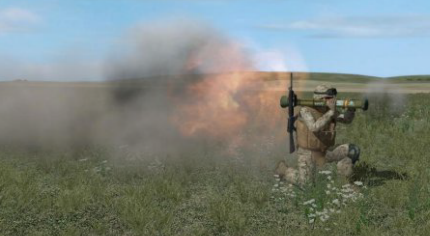Virtual reality gets real with Army's 3D game update
Virtual Battle Space 3 recreates not only battlefield scenarios but users’ real-life capabilities—and limitations.

The Army is getting more real with its 3D training game, Virtual Battle Space 3, by creating avatars that match the strength, endurance and skills of the users rather than letting them take the virtual field in the shape of a sinewy virtual super warrior.
The game, known as VBS3 for short, has added human dimension modeling with which soldiers enter their own height, weight, Army Physical Fitness Test (APFT) scores and their weapons qualifications scores, the Army said in a release. The result is a more realistic virtual reality experience. If a soldier is overweight, the avatar will look dumpy. If he’s not in the best of shape, he will get tired more quickly. If she’s not qualified to use a particular weapon in real life, she can’t use it in the game.
“The avatar will only be as capable as the individual soldier," said Robert Munsey, an analyst with the Army Training and Doctrine Command Capability Manager for Virtual & Gaming.
The game also has created more realistic scenes and scenarios, and added features such as an "ambience" plugin that puts crowds of simulated personnel into a situation, so that users “see the normal pattern of life so it's not vacated of civilians," Munsey said. "Insurgent ambience," another addition, simulates the activities of an insurgent cell, which can launch attacks.
Virtual Battle Space, created by Bohemia Interactive Australia, has been around since the early aughts, first used by the Marine Corps and the Australian Army. By the time VBS2 appeared in 2007, military leaders were seeing the value of virtual games as an inexpensive way of familiarizing soldiers with battlefield scenarios. When the Army created Games for Training as a program of record in 2009, it selected VBS2 as its centerpiece.
Intended for units at the company level and below, VBS3 has more than 150 battle drills, platoon tasks and other maneuvers and, like VBS2, can be used to give soldiers a look at a simulated situation before they encounter the real thing.
And with the latest iteration, the game depicts not just the battlefield scenario, but the actual soldier using the game.
"When they tested this last year, one of the soldiers said 'I look fat,'" Munsey said. "And the other soldier sitting right next to him said 'that's because you are fat.'"
The game has a fatigue bar on the left side that corresponds to the user’s APFT score. If a solider has a score of 160 (average is 220) that bar will drop faster, limiting what the player can do, than it would for the “stud or studette at [a score of] 300-plus," Munsey said.
"If the soldier is one of those 270-300 physical training performers, the fatigue model will model that in the game," he said. "Then the leaders, the small unit leaders have the capability to understand the performance of their squad."
Considering that a big part of gaming’s appeal as a training tool is the motivation of scoring points—getting to a next level, achieving a high score—VBS3 might even prompt some soldiers to improve their conditioning.




